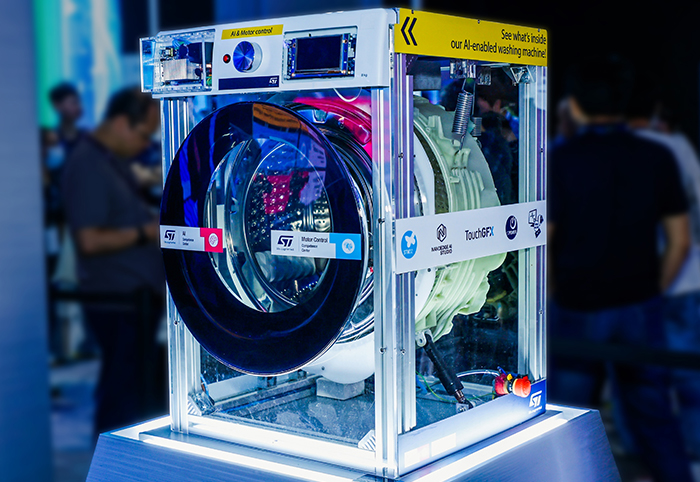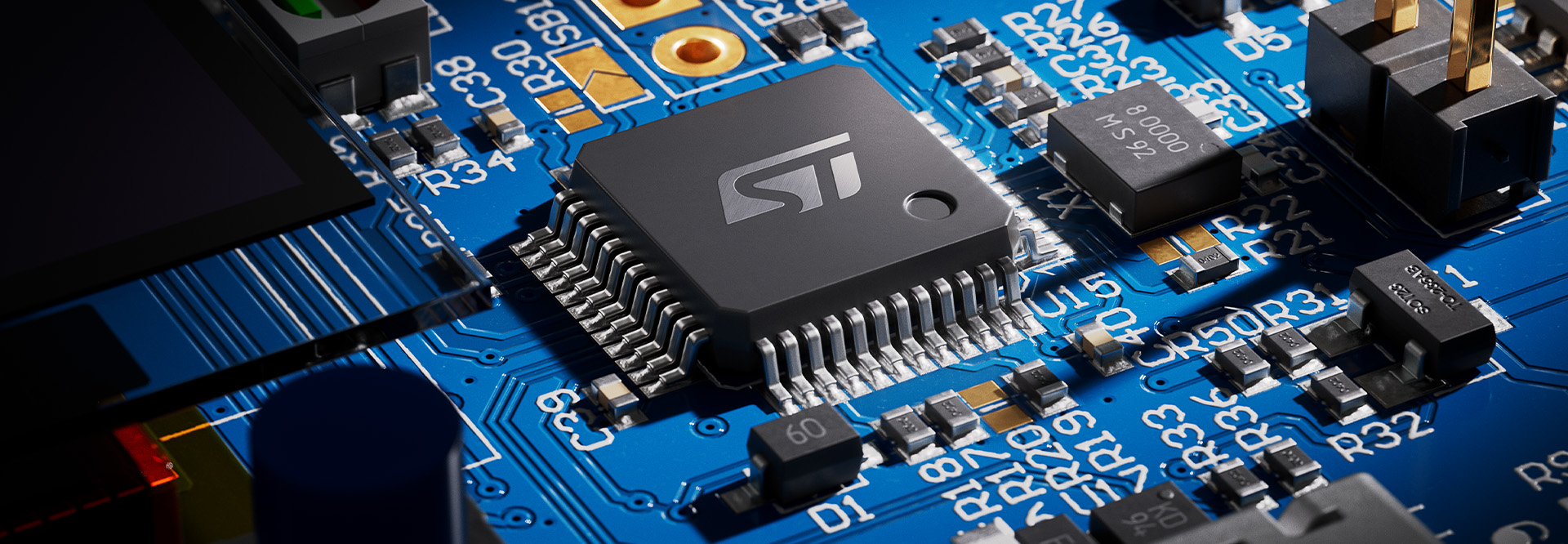Sustainable technology
Our technology plays a key role in helping to solve environmental and societal challenges.
2011
launch of product stewardship program
23.2%
of revenue from responsible products
95%
of our products exceed RoHS directives
At ST, we develop technologies that are key enablers for creating a more sustainable future. Sustainable technology is our comprehensive product stewardship program that aims to ensure sustainability is considered when we develop new products and technologies. It helps us create value for our Company, our customers, and society in general. 3-3
Our responsible products
Our sustainable technology program enables us to classify our products into four categories of ‘responsible products’ that provide environmental and social benefits.
Responsible products
A product is given a ‘responsible product’ label when it can demonstrate that it enables social or environmental benefits. Examples of responsible products are available at www.st.com.
In 2023, we identified 82% of our new products as responsible, compared to 77% in 2022. We progressed towards our 2027 goal to generate at least 33% of our revenues from responsible products, reaching 23.2%, compared to 22.6% in 2022.
ST new products in 2023 417-1
Our lifecycle approach
Since launching our product stewardship program in 2011, we have applied a robust product lifecycle approach. This means we seek to improve the social and environmental impact at every stage of a product’s life. Our lifecycle assessment (LCA) methodology has been developed in line with ISO standards 14040 and 14044.
In 2023, to better support our customers and enhance data accuracy and robustness, we scaled up our LCA methodology. We can now provide the carbon footprint for 98% of our products based on semi-automated LCA methodology. Furthermore, we can undertake an LCA for any product in our portfolio based on specific product parameters. At the end of 2023, we initiated the certification of our LCA process to ISO standard 14067.
Enabling technologies and eco-design
ST creates advanced semiconductor technologies by offering innovative power electronic solutions based on wide-bandgap technologies, such as silicon carbide (SiC) and gallium nitride (GaN). These technologies enable the creation of energy-efficient responsible applications (see ST process and packaging technologies).
By keeping eco-design at the heart of our product development, our designers innovate to create low-carbon and power-efficient products. Our product management system tracks key indicators to encourage our product development teams to implement green designs wherever possible.
Responsible supply chain
Our responsibility begins with the raw materials and resources we use to manufacture our products. All our raw materials are sourced in line with the latest environmental and social guidelines, and sustainability criteria are included in our purchasing processes (see Responsible supply chain and Responsible mineral sourcing).
Clean production
We strive to reduce the impact of our manufacturing activities on natural resources by managing our greenhouse gas (GHG) emissions, reducing our energy, water, and chemical consumption, and recycling waste.
Low power products and sustainable usage
Reducing the power consumption of electronic devices is a major focus of our strategy, helping to reduce our environmental footprint year after year. Yet our products go beyond power efficiency and contribute in other ways to address environmental and social challenges (see ‘Considering our product handprint’ below).
End of life recycling
95%
of our products exceed RoHS directives
We strive to ensure our products meet or exceed applicable environmental requirements, such as REACH(1), RoHS(2), and
HSPM(3) (see Chemicals). ECOPACK processes and classification help us monitor the substances used in our products, which in turn facilitates end of life and recycling when our devices are disposed of. By the end of 2023, 95% of our products exceeded RoHS directives and were rated ECOPACK2 or ECOPACK3.
Considering our product handprint
As well as continually working on reducing our product footprint, we also strive to increase our product handprint. Handprint refers to a positive impact on the system or the application in which the product is integrated. This might be by enabling a green or social application, contributing to a reduction in the footprint of the application, or by consuming less energy than current alternatives.

Jean-Louis Champseix
Group Vice President, Corporate Sustainability
At ST, we view sustainability as a question of balance. We strive to reduce our environmental footprint while increasing our product handprint with sustainable technologies. By doing so, we enable our customers to create products that have a more positive impact on the world. This approach supports our sustainable growth, minimizing risks and creating long-term value for our stakeholders, as we move towards a more responsible future.
Enabling green or social applications
Enabling the transition to planet-friendly alternatives, our semiconductor solutions are used in a wide variety of environmental applications, from electric mobility and renewable energy grids to smart industries. In addition, our products and technologies cater for a wide variety of human-welfare applications with social benefits.
As an example, several ST products are indispensable for car electrification, such as traction inverters and onboard chargers. (see ST products and solutions). In 2023, a collaborative smart farm project was completed that uses ST chips and technical expertise for an air probe aimed at optimizing efficiency and reducing GHG emissions.
Reducing power consumption
Thanks to specific product features, our products can significantly contribute to reducing power consumption (and thus GHG emissions) of the application they are embedded in. For example, a Time-of-Flight sensor embedded in a laptop with the Presence turnkey solution, can save a significant amount of electricity by automatically switching to power saving mode when the laptop is idle. This carbon saving exceeds by far the emissions generated by the production and use of the chip itself. See focus, below, for another example.
FOCUS

A ZeST to create positive environmental impact
In 2023, we launched ‘STM32 ZeST’ (zero speed full torque), a new embedded software that reduces electricity consumption. When applied to a washing machine, it can reduce electricity consumption by at least 10%. This represents approximately 110kWh of energy saved over the lifespan of the machine. It is a clear demonstration of product handprint, as the embedded device brings a substantial positive environmental impact.
All ST devices required for the washing machine to operate, such as voltage regulators, inverters, microcontrollers, converters, and diodes, generate carbon emissions during their lifecycle. This is mainly due to manufacturing and use. However, thanks to the ZeST, the handprint outweighs the carbon footprint, resulting in a net positive impact.
Additionally, we use Edge AI (NanoEdge AI Studio) technology to estimate the weight of the laundry to be washed, based on motor current measurements. We have created a virtual sensor that determines the weight of the laundry using data already available in the microcontroller that controls the motor. The washing machine can then adjust its water consumption according to the actual load, reducing water consumption.
This is not restricted to high-end washing machines. Since it does not require additional devices to perform the function, it is accessible to mid-range appliances at virtually no extra cost and can be deployed on a large scale.
Consuming less
Our Stellar automotive microcontrollers (MCUs) are an example of reduced energy consumption, as they significantly improve the efficiency of cars (and therefore their energy consumption) and reduce CO2 emissions. Stellar MCUs offer a reduced lifetime carbon footprint compared to previous-generation MCUs. A case study was conducted using the body platforms of a major original equipment manufacturer (OEM), to compare the emissions of a next-generation platform using Stellar MCUs, with a current platform using current-generation MCUs.
The results showed that:
- The manufacturing process for the Stellar device produced 40% less CO2 emissions compared to the previous generation solution for the platform.
- Over the lifetime of the vehicle, the CO2 emissions of the Stellar MCU solution were 30% lower than the previous generation solutions, while maintaining the same level of performance.
- Overall, the calculations revealed a significant reduction in CO2 emissions for the Stellar MCU solution throughout the manufacturing and lifetime of the vehicle.
2027 sustainability goal |
Status |
Comments |
SG2: Generate at least 33% of our revenues from our Sustainable Technology’s most advanced responsible products by 2027. |
23.2% |
(1) REACH: Registration, Evaluation, Authorization and Restriction of Chemicals.
(2) RoHS: Restriction of Hazardous Substances.
(3) HSPM: Hazardous Substance Process Management.


